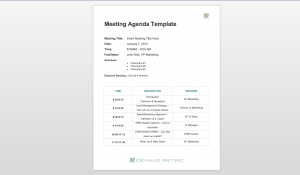Meeting Mayhem: Managing Meeting Time Like a Boss

These days, it seems like we’re in meetings more than actually getting any work done. Meetings can be a time suck if you let them. It takes effort -- and tips like these -- to get meetings back on track and more productive.
Tip 1: Have an Agenda
It’s all too easy to try to make one meeting cover everything that’s going on with a project, and it might seem to be an effective way to get more done, but the converse is true. People’s attention spans are short, and trying to jam too many topics into a single meeting will make their eyes glaze over. They’ll never remember it all. Additionally, meeting attendees may try to tack their own topics of interest onto a meeting, making it longer than necessary.
Send a meeting agenda to all attendees the day of the meeting, and encourage people with other topics to discuss to get on the next meeting’s agenda.
Tip 2: Invite Only Key People
Is it really necessary that all 20 people on a team attend a meeting that really only affects three? Keep the rest of your team effectively working at their desks while the people who are actually involved in a project meet about it. This keeps meetings short, and the people that participate will be more likely to pay attention if the meeting directly affects them.
Tip 3: Give the Meeting a Time Limit
Whether your team fully adopts Agile practices or not, the standup meeting is one worth implementing. Spending just 5 minutes on a meeting might seem impossible, but it really boils down discussion to what’s urgent. Holding short meetings daily can keep everyone in the loop about the progress of a project and identify bottlenecks that can be removed before they throw off the project timeline. And they’re short enough that anyone has time to attend!
Tip 4: Send a Recap
An emailed recap of the meeting highlights is useful both to those who didn’t attend the meeting as well as those who did but didn’t take notes. Identify tasks and the person responsible for them so that everyone takes care of their responsibilities in a timely manner.
A recap can also help to review at the next meeting, as it serves as meeting minutes and refreshes everyone’s mind on the topics du jour.
Tip 5: Take Further Conversation Offline
Everyone wants to have their say in a meeting, but that can prolong it unnecessarily. Instead, invite those opinionated team members to talk to you “offline” after the meeting so they don’t hold others up from getting back to work.
By keeping your meetings short, focused, and directed, you’ll be able to cut down wasted time and keep your projects on track, while still keeping everyone informed and in the loop. Your employees will thank you. No one likes sacrificing productivity to endless time spent in meeting after meeting.
Meetings are, of course, essential to the growth of any business, but it’s far too easy to let them take over like weeds. Creating a meeting policy can give guidelines to how meetings are held in your business, and can help your staff balance their time between discussing projects in meetings and actually working on tasks.
Megan Totka is the Chief Editor for ChamberofCommerce.com. ChamberofCommerce.com helps small businesses grow their business on the web and facilitates connectivity between local businesses and more than 7,000 Chambers of Commerce worldwide. She specializes on the topic of small business tips and resources and business news. Megan has several years of experience on the topics of small business marketing, copywriting, SEO, online conversions and social media. Megan spends much of her time establishing new relationships for ChamberofCommerce.com, publishing weekly newsletters educating small business on the importance of web presence, and contributing to a number of publications on the web. Megan can be reached at [email protected]. Website: www.chamberofcommerce.com

